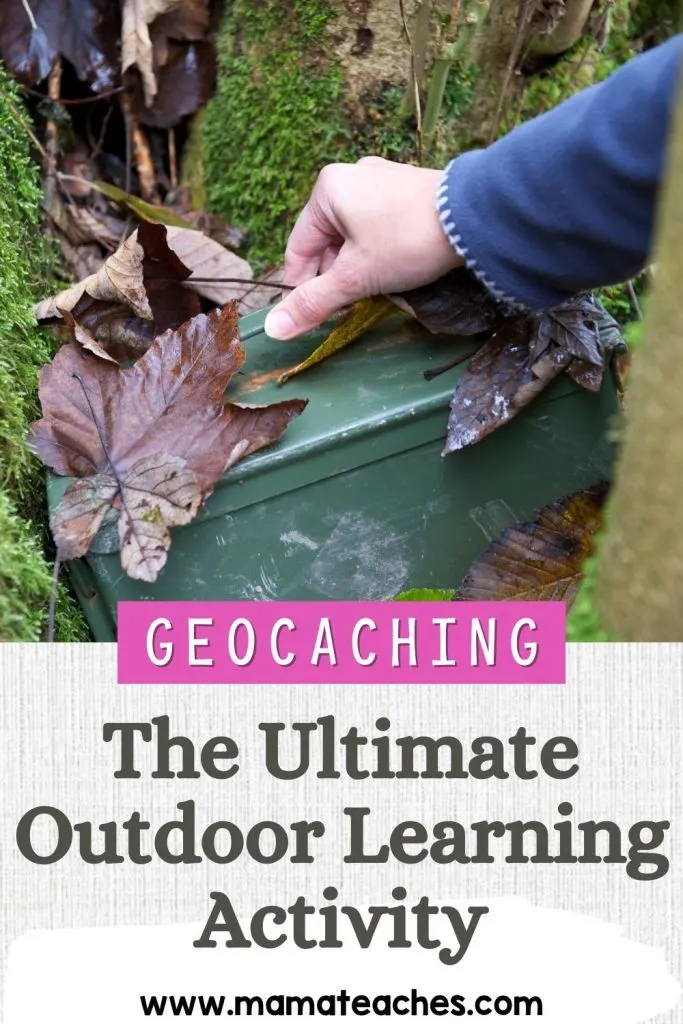Do you like the idea of exploring new places with purpose, learning to navigate, and spending time together outdoors?
Try geocaching, the high-tech treasure hunt!

This article contains affiliate links to things that you might like.
What Is Geocaching?
Geocaching is an outdoor activity where people use GPS to hide and seek small waterproof containers (called “caches”).
The cache may contain simply a logbook and pencil, or it may include tiny items called SWAG (for “stuff we all get”).
The SWAG may be lapel pins, small toys, unusual coins, books, CDs, keychains, etc.
Upon locating the cache, the finder writes her name and date in the logbook (or uploads it online) and then selects an item from the box.
The finder should replace the item with one of her own.

How to Get Started Geocaching
The first thing you need is to download a geocaching app to your smartphone (such as the aptly named Geocaching app).
Geocaching is a subscription-based service, but they have caches available for free to all users.
Some of the caches are simple to access and find (they have a 1-star rating), while others (like 5-star caches) require experience, long treks, and even specialized equipment.
If you are geocaching with a young child, begin with 1-star caches.
Each cache has a listed size from micro/extra-small (like a film container) to large (like a bucket).
The smaller caches will likely just contain a logbook while the regular to larger size caches will contain trade items.
These are the ones kids especially like to find (they want the SWAG!).

Here’s what you need to begin after you have created an account with Geocaching:
1 – Your chosen cache loaded on your smartphone (or the coordinates downloaded to your stand-alone GPS unit)
2 – An assortment of trinkets to exchange (these should be of equal or greater value to the SWAG you find in the cache)
3 – Water bottle and snacks
4 – Pen for filling out the logbook
It’s also handy to have a flashlight and trekking pole to poke around and find the cache.
The app only shows you the location of the cache; it does not tell you the route to get there.
It also is only accurate within about 30 feet, so once you are close, you need to start looking.
This is a great opportunity to work on your skills of observation, ingenuity, and persistence!

Ways to Use Geocaching in Your Homeschooling
Geocaching is more than a family fun activity.
You can use it for homeschooling as well–from elementary to high school!
Physical Education
Okay, this one is pretty obvious, but geocaching is great exercise.
Your child may balk at the idea of running laps or doing jumping jacks, but he will enthusiastically trek to locate a cache.
Exploring State Parks and Historic Sites
If you don’t have a nature lover or history buff in your house, educational field trips can be a hard sell.
However, these same places are often gold mines for geocaching.
Writing Prompts
The most common complaint of young writers is “I don’t know what to write about!” Have your student keep a geocaching logbook of where you searched, how you found the cache, and what was inside.

Map Reading and Orienteering
You can transfer the GPS coordinates to a map (after all, it is just latitude and longitude) and give your older children only the map and compass to use in navigation.
(You can keep the smartphone as a failsafe).
They will have to read the map and use the compass to find their way.
Local Geography and Nature Study
Are you learning about types of rocks, trees, birds or your local geography (like rivers, hills, and lakes)?
Explore them while geocaching!
Practical Use of Math
In addition to the math of map navigation, you can learn about how GPS works.
Believe it or not, it is all geometry!
This is a great research project with loads of practical application.

Geocaching and Outdoor Learning
Turn education into an adventure with geocaching.
It can provide, quite literally, the breath of fresh air that your homeschool needs.
